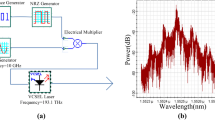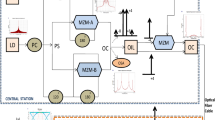Abstract
The radio over fiber technology is one of the swiftly growing sector since decades, as it takes benefit of the enormous bandwidth obtainable by optical communication systems as well as there is no requirement for digital to analog or analog to digital conversions. Thus, it is widely explored as the next generation optical communication technique. In this view, the article presents proposed novel optical orthogonal frequency division multiplexing (OOFDM) link, performance investigated with EDFA for numerous bit logical signals, data rates and optical modulators over single mode fiber. The results depict better transmission performance for the cyclic prefix 0.5, in lower dispersion range, for QPSK to 1024QAM, rise in number of subcarrier at numerous data rates over the transmission reach of 100 km. The chirp factor, extinction ratio significantly affects transmission performance, for optimum performance with LinEAM, LinAM, Sin2AM, the chirp factor \(\ge \)2, 8, 3 be selected respectively and the extinction ratio be more than 15 with Sin2AMOOFDM. Further, it depicted improved performance with \(\hbox {V}_\mathrm{pi}\) in the lower range for phase modulator, lower amplitude range and \(\hbox {V}_\mathrm{ON}\) (maximum transmissivity offset) in the range of 1 to 4 for Sin2AM, \(\hbox {V}_\mathrm{max}> 5\) and \(\hbox {V}_\mathrm{min}\) \(-3\) to \(-1\) with linear electro absorption modulator and higher data rates with higher number of logical levels (QAM_bit_number). Eventually, the phase modulated and linear amplitude modulated orthogonal frequency division multiplexing signal transmission over fiber has illustrated enhanced performance than with other optical modulators. The investigation inferred that presented work would be significant illustration towards development of more efficient next generation optical communication networks.

























Similar content being viewed by others
References
Agrawal, G.P.: Nonlinear Fiber Optics, 2nd edn. Academic Press, San Diego (1995)
Ali, A., Leibrich, J., Rosenkranz, W.: Spectral efficiency and receiver sensitivity in direct detection optical-OFDM. OSA/OFC/NFOEC2009, paper OMT7 (2009)
Ali, A., Paul, H., Leibrich, J., Rosenkranz, W., Kammeyer, K.-D.: Optical biasing in direct detection optical-OFDM for improving receiver sensitivity. OSA/OFC/NFOEC 2010, paper JThA12 (2010)
Armstrong, J.: OFDM for optical communications. J. Light Wave Technol. 27(3), 189–204 (2009)
Browning, C., Reid, D.A., et al.: Direct detection optical OFDM over single mode fibre simulation. In: China-Ireland International Conference on Information and Communications Technologies 2010 SciRes, pp. 140–44 (2010)
Chahine, A.S., Okonkwo, U.A.K., Ngah, R.: Study the performance of OFDM radio over fiber for wireless and communication systems. Presented at the IEEE international RF and microwave conference, pp. 2–4. (2008)
Devendra Kr. et al.: Performance Investigation in Optical OFDM. Carib.j.SciTech. vol. 1, pp. 116–122. ISSN: 0799–3757. http://caribjscitech.com/ (2013)
Dimitrov, S., Haas, H.: Information rate of OFDM based optical wireless communication systems with nonlinear distortion. IEEE J. Lightwave Technol. 31(6), 918–929 (2013). doi:10.1109/JLT.2012.2236642
Djordjevic, I.B., Vasic, B.: Orthogonal frequency division multiplexing for high-speed optical transmission. Opt. Express 14(9), 3767–3775 (2006)
Engels, M.: Wireless OFDM systems: how to make them work? In: The Kluwer International Series in Engineering and Computer Science 2002. 692 (2002). doi:10.1007/b117438.
Galwas, B.A.: Generation of Intermodulation Distortions by Electro-Optical Modulators, Warsaw University of Technology. http://www.researchgate.net/publication/229037934_Generation_of_Intermodulation_Distortions
Hanzo, L., Munster, M., Choi, B.J., Keller, T.: OFDM and MC-CDMA for Broadband Multi-User Communications, WLANs and Broadcasting. Wiley, New York (2003)
Hara, S., Prasad, R.: Multicarrier Techniques for 4G Mobile Communications. Artech House, Boston (2003)
Jolley, N.E., Kee, H., Rickard, R., et al.: Generation and propagation of a 1550 nm 10 Gb/s optical orthogonal frequency division multiplexed signal over 1000 m of multimode fibre using a directly modulated DFB. In: Proceedings of Optical Fiber Communication Conference, OFC’2005, Paper OFP3 (2005)
Kashany-Mizrahi, I., Sadot, D.: Low-cost adaptive directly modulated optical OFDM based on semiconductor optical amplifier. Opt. Fiber Technol. 19, 501–506 (2013)
Koyama, F., Iga, K.: Frequency chirping in external modulators. J. Lightwave Technol. 6(1), 87–93 (1988)
Lowery, A.J.: mproving sensitivity and spectral efficiency in direct-detection optical OFDM systems. OFC/NFOEC 2008, paper OMM4 (2008)
Lowery, A.J., Armstrong, J.: Orthogonal-frequency-division multiplexing for dispersion compensation of long-haul optical systems. Opt. Express 14(6), 2079–2084 (2006)
Peng, W.-R., Wu, X., Feng, K.-M., Arbab, V.R., Shamee, B., et al.: Spectrally efficient direct-detected OFDM transmission employing an iterative estimation and cancellation technique. Opt. Express 17(11), 9099–9111 (2009)
Schmidt, B.J.C., Lowery, A.J., Du, L.B.: Low sample rate transmitter for direct-detection optical OFDM. In: Proceedings of Optical Fiber Communication Conference. OFC 2009, San Diego, CA, paper OWM4 (2009)
Schuster, M., Randel, S., Bunge, C.A., Lee, S.C.J., Breyer, F., et al.: Spectrally efficient compatible single-sideband modulation for OFDM transmission with direct detection. IEEE Photon. Technol. Lett. 20(9), 670–672 (2008)
Seimetz, M., Weinert, C.M.: Options, feasibility, and availability of \(2 \times 490^{\circ }\) hybrids for coherent optical systems. J. Lightwave Technol. 24, 1317–1322 (2006)
Shieh, W., Athaudage, C.: Coherent optical orthogonal frequency division multiplexing. Electron. Lett. 42(10), 587–589 (2006)
Shieh, W., Athaudage, C.: Coherent optical orthogonal frequency division multiplexing. Electron. Lett. 42(10), 587–589 (2006)
Winzer, P.J., Essiambre, R.-J.: Advanced modulation formats for high-capacity optical transport networks. J. Lightwave Technol. 24(12), 4711–4728 (2006)
Xu, Z., O’Sullivan, M., Hui, R.: OFDM system implementation using compatible SSB modulation with a dual-electrode MZM. Opt. Lett. 35(8), 1221–1223 (2010)
Yin, H.J., Alamouti, S.: FDMA: A broadband wireless access technology. Presented at the IEEE Sarnoff symposium conference, pp. 27–28. (2006)
Acknowledgments
Thanks to J.K. Institute of Applied Physics and Technology Allahabad (University of Allahabad-India) for providing the software OptSim(R-Soft) optical communication system.
Author information
Authors and Affiliations
Corresponding author
Rights and permissions
About this article
Cite this article
Tripathi, D.K., Singh, P., Shukla, N.K. et al. Performance investigation of the OFDM over SMF. Opt Quant Electron 47, 643–662 (2015). https://doi.org/10.1007/s11082-014-9941-z
Received:
Accepted:
Published:
Issue Date:
DOI: https://doi.org/10.1007/s11082-014-9941-z




